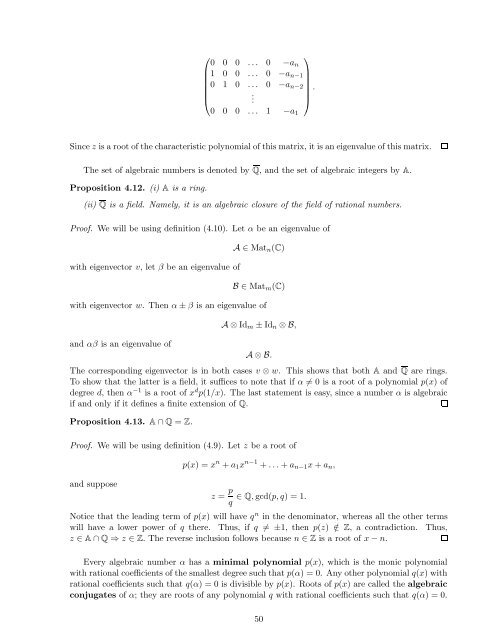Lecture notes for Introduction to Representation Theory
Lecture notes for Introduction to Representation Theory
Lecture notes for Introduction to Representation Theory
You also want an ePaper? Increase the reach of your titles
YUMPU automatically turns print PDFs into web optimized ePapers that Google loves.
⇒<br />
⇒<br />
⎧ <br />
0 0 0 . . . 0 −an<br />
1 0 0 . . . 0 −a n−1 0 1 0 . . . 0 −a n−2 .<br />
<br />
⎜<br />
. ⎝<br />
0 0 0 . . . 1 −a 1<br />
Since z is a root of the characteristic polynomial of this matrix, it is an eigenvalue of this matrix.<br />
The set of algebraic numbers is denoted by Q, and the set of algebraic integers by A.<br />
Proposition 4.12. (i) A is a ring.<br />
(ii) Q is a field. Namely, it is an algebraic closure of the field of rational numbers.<br />
Proof. We will be using definition (4.10). Let ϕ be an eigenvalue of<br />
with eigenvec<strong>to</strong>r v, let α be an eigenvalue of<br />
A Mat n (C)<br />
B Mat m (C)<br />
with eigenvec<strong>to</strong>r w. Then ϕ ± α is an eigenvalue of<br />
and ϕα is an eigenvalue of<br />
A Id m ± Id n B,<br />
A B.<br />
The corresponding eigenvec<strong>to</strong>r is in both cases v w. This shows that both A and Q are rings.<br />
To show that the latter is a field, it suffices <strong>to</strong> note that if ϕ = 0 is a root of a polynomial p(x) of<br />
degree d, then ϕ −1 is a root of xdp(1/x). The last statement is easy, since a number ϕ is algebraic<br />
if and only if it defines a finite extension of Q.<br />
Proposition 4.13. A ∈ Q = Z.<br />
Proof. We will be using definition (4.9). Let z be a root of<br />
n<br />
p(x) = x + a 1 x n−1 + . . . + a n−1 x + a n ,<br />
and suppose<br />
z = p q<br />
Q, gcd(p, q) = 1.<br />
Notice that the leading term of p(x) will have q n in the denomina<strong>to</strong>r, whereas all the other terms<br />
will have a lower power of q there. Thus, if q = ±1, then p(z) / Z, a contradiction. Thus,<br />
z A ∈ Q ≥ z Z. The reverse inclusion follows because n Z is a root of x − n.<br />
Every algebraic number ϕ has a minimal polynomial p(x), which is the monic polynomial<br />
with rational coefficients of the smallest degree such that p(ϕ) = 0. Any other polynomial q(x) with<br />
rational coefficients such that q(ϕ) = 0 is divisible by p(x). Roots of p(x) are called the algebraic<br />
conjugates of ϕ; they are roots of any polynomial q with rational coefficients such that q(ϕ) = 0.<br />
50

















